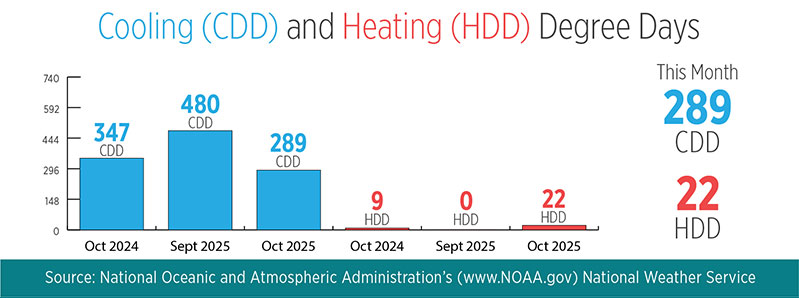What to Expect on Your November Bill

Fall arrived a little later than normal this year, but when it did, temperatures dropped quickly and so did energy use for CoServ Members.
Best of all, CoServ Members will notice their electricity rate is a little lower this month. There are two reasons for that, which we will address below.
October Comes in Hot Before Finally Cooling Down
Temperatures ran the whole gamut in October.
Early on, October felt more like summer with high temperatures in the 90s, which meant CoServ Members needed air conditioning daily. It wasn’t until mid-October that temperatures finally started feeling like fall.
After Oct. 21, the highs hovered around the 70s and 80s with low temperatures in the 50s and even 40s.
The Cooling Degree Days (CDD) below reflect the higher temperatures from the beginning of the month. The closer the average temperature is to 65, the less energy is needed to stay comfortable in your home. The average temperature was 84 degrees, one degree cooler than the same month in 2024. As a result, the CDD were slightly lower this year compared to last year.
| September | October | Difference | |
|---|---|---|---|
| Average temperature | 80.8 | 73.4 | 7.4 degrees cooler |
| Heating Degree Days | 0 | 22 | 22 more HDD |
| Cooling Degree Days | 480 | 289 | 191 less CDD |
| Utilities and the federal government measure the impact of weather on energy usage by calculating Cooling Degree Days (CDD) and Heating Degree Days (HDD). To calculate the CDD, take the average temperature for a day and subtract it from 65. The higher the number, the more air conditioning will be needed to keep your home comfortable. Click here for more information on calculating CDD. | |||
North Texans may have even turned on their heaters on the last days of the month when temperatures reached lows in the low 40s. That’s reflected in the Heating Degree Days in the chart above.
Overall, Members should expect energy usage to be less than September 2025.
October was also unusually dry in the first half of the month with no recorded rainfall until Oct. 18. Then, a deluge happened on Oct. 24-25 that dumped 4.51 inches of rain. North Texas ended the month with above-normal rainfall.
Power Costs Drop Again
CoServ’s electricity rate is the lowest it’s been since the summer of 2023.
By making strategic power purchases, CoServ has been able to capitalize on lower wholesale power costs. Because CoServ has 100% control over its power purchases, when we save money on wholesale electricity, we pass that on to Members, as we did this month.
We account for fluctuations in wholesale electricity costs by adjusting the Power Cost Recovery Factor (PCRF) up or down.
For November billing, the PCRF was lowered to -0.015, half a penny less than October. A negative PCRF subtracts from the base rate. The lower PCRF will save Members about $5 for every 1,000 kWh of usage compared to last month. This marks the 17th straight month where CoServ’s PCRF is negative.
The Standard residential rate will be 11.31 cents per kilowatt-hour.
Click here to learn more about how your CoServ rate is calculated.
Click here to compare our rates to the average retail electric provider in North Texas.
Electric Rate Changes
Starting Nov. 1, most rate classes will experience a revenue-neutral change based on average usage, with a $5 increase to their monthly Customer Charges balanced by lower base usage rates.
For Members on the Standard residential rate, the per kWh charge will be -$0.004119 cents cheaper, or four tenths of a penny.
For an average Member using 1,227 kilowatt-hours, the impact to their bill will be negligible. For those that use more than this, they will see a slight decrease in their bills, and for those that use less, they will see a small increase.
Click here for more information on the Revenue Neutral Rate Change.





